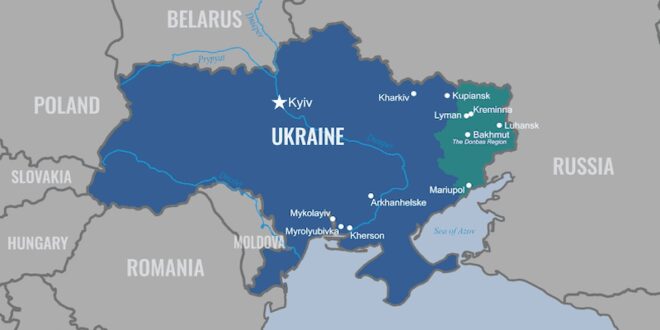- Battlefield Update
Last week’s fighting brought few frontline changes, save for minor Russian tactical advances: the war remains positional. The overall situation, nonetheless, should not be characterized as a stalemate. Ukrainian engineering units have not matched their Russian counterparts in defensive depth-building, while Ukraine’s military resilience has been tied to Western assistance programs. Any diminution of that support could cause breaches across the Ukrainian lines, likely followed by large withdrawals or, even worse, by collapses.
The Russian military’s efforts in recent weeks have concentrated on the southeastern and eastern portions of the front line, focused on capturing the unoccupied parts of Luhansk and Donetsk Oblasts. Recently, Russian forces have been conducting a push along the line from Svatove to Kreminna, in addition to envelopment attempts in Avdiivka. Positional fighting between Russian and Ukrainian forces has continued, with Kupiansk, Svatove, and Siversk looming large as important flashpoints.
Positional fighting around Avdiivka continued intensively this week, with artillery-heavy combat operations. Russian combat formations have been trying to encircle the city, forming an envelopment axis from Stepova in the north to Sieverne in the south.
In the south near Sieverne, Russia’s main priority is to maintain its buildup along the front line, while reversing Ukraine’s tactical gains along the axis from Robotyne to Verbove. The Russian military has been pushing hard for Robotyne, with only incremental gains to show for it. Open-source intelligence from this area confirms that Ukrainian forces are now on the defensive there against Russian combat formations.
With the temperature below freezing and forecasts predicting similar weather conditions until March, frozen ground has allowed the larger-scale ground operations and rapid cross-country movements that had been impeded by the muddy season. However, current weather forecasts also call for potentially heavy snow, which could hinder troop movement and maneuverability. Freezing weather and reduced daylight hours have required both sides to rely on winter equipment, such as night vision goggles, thermal cameras, and warm clothing.
Russian aerial assaults also continued this week at full pace. On January 13, Russian forces attacked Ukraine with a mixed strike package that resembled most of its recent attacks. According to the Ukrainian Air Force, the aerial assault included various missiles—Kh-22 anti-ship missiles; S-300 and S-400 surface-to-air missiles modified for land-attack roles; Kh-101, Kh-555, and Kh-59 air-launched cruise missiles; and Kh-31P anti-radiation missiles—and loitering munitions featuring the Iranian Shahed baseline.
Per Ukrainian authorities, eight of these missiles were successfully shot down. Allegedly, Ukraine’s electronic warfare (EW) deterrent neutralized a further 20 of the missiles before they reached their targets. Yet these successes still account for roughly half of the missiles in the Russian strike package. Given the offense-dominant nature of missile and drone warfare, the salvos that breached Ukraine’s air defenses still pose a significant threat to the country’s infrastructure. According to United Kingdom intelligence, the majority of Russian aerial assaults now target the production capacity of Ukraine’s defense industry. This suggests that Russia is pursuing a new strategy after targeting Ukraine’s energy infrastructure for much of last year.
- Ukraine Hits Important Russian Assets in the Air
Overnight on January 14, Ukrainian news outlets claimed that the Ukrainian Armed Forces struck a Russian IL-22M signals intelligence (SIGINT) aircraft and shot down an A-50 Mainstay (Beriev) airborne early warning and control aircraft (AEW&C) over the Sea of Azov and the Black Sea. The targeted Russian aircraft serve as flying nerve centers for Moscow’s logistics efforts. Therefore, the incidents count among the most significant achievements for Ukraine’s air defense crews since the outset of the war.
Russian military bloggers announced the events cautiously, portraying them as incidents of friendly fire. Regardless of the source of the damage, the IL-22M was heavily mangled, and the A-50 may be irreparable. The Russian military has suffered a serious blow.
As previous editions of this report have depicted, the Ukrainian military has likely intensified its air defense architecture in the southern sector of battle, preying on Russian aircraft from long distances. Ambushing the Russian Aerospace Forces with strategic SAM systems—predominantly Patriot variants—has proven successful for Ukrainian forces, which previously have also downed Russian Su-30SM and Su-34 tactical assets.
- North Korean Missiles Enter the Fight
According to recent United States intelligence, in late December 2023 North Korea supplied Russia with ballistic missile launchers and several dozen tactical ballistic missiles. As per official reports by Ukraine and the US, the Russian aerial attacks against Ukraine on December 30, 2023, and January 2, 2024, included some of these short-range ballistic missiles.
Given Russia’s growing defense ties with Pyongyang and Tehran, Moscow will likely face no shortage of missiles, artillery rounds, or drone warfare assets in the coming months. With their quasi-ballistic trajectories and heavy warheads, tactical ballistic missiles will make things more difficult for Ukraine. It remains to be seen if Iran will follow North Korea’s gesture and provide Russia with its Fateh-110 derivative solid-propellant, road-mobile tactical ballistic missiles. The strengthening partnership between Pyongyang and Moscow could also solve Moscow’s ongoing problems with producing enough SS-26 Iskander ballistic missiles.
- First-Person View Drones Remain Vital in Ukraine’s Efforts to Guard its Dnipro Bridgehead
Led by the Ministry of Digital Transformation, Ukraine’s “drone army” is fast expanding. Miniature unmanned aerial vehicles (UAVs) and first-person-view (FPV) drones have become important components of Ukraine’s military operations.
Ukrainian forces are effectively using FPV drones to target and neutralize Russian troops and equipment along the Dnipro River in an attempt to protect their tactically important bridgeheads. Reports from the battlefield hint at a high rate of success for Ukraine against Russian military equipment near Krynky.
Ukraine’s 35th Marine Brigade has established a stubborn presence along Krynky’s Russian-occupied left bank, inflicting heavy casualties on Russia’s newly formed 18th Combined Army. According to Ukrainian sources, the 17th Tank Regiment from the Russian 70th Motorized Rifle Division has spent the previous two weeks evacuating disabled armored vehicles from the battlefield across the T-2206 highway south of Krynky.
 Eurasia Press & News
Eurasia Press & News



